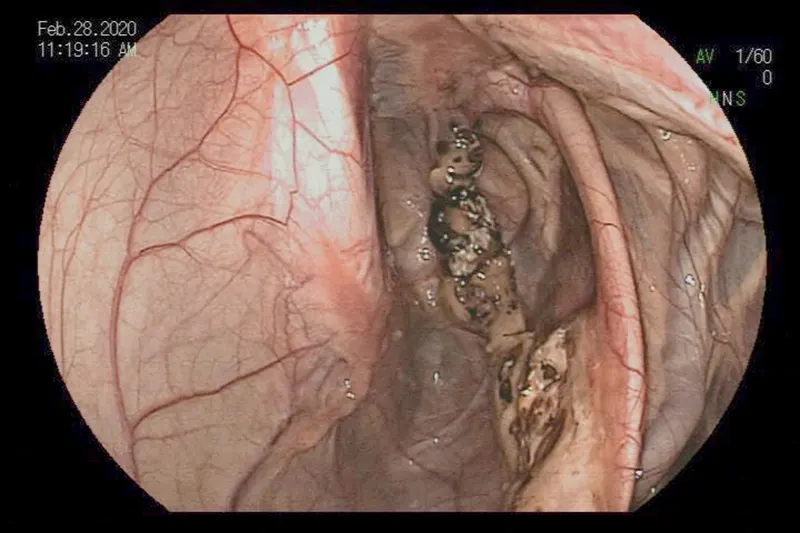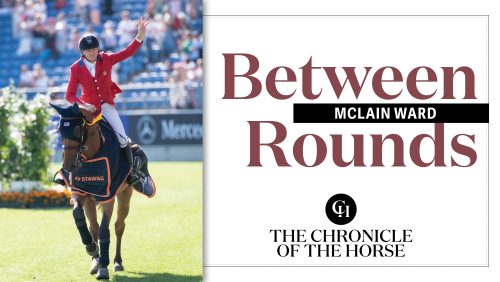“I use the heart rate monitor on her when I ride her,” Nicole Shahinian-Simpson told veterinarian David Freeman, MVB, Ph.D., DACVS, in a follow-up conversation a few weeks after he performed surgery on her grand prix show jumper Akuna Mattata. “Her heart rate is race horse level. Are these plugs going to hold?”
The two nitinol plugs Shahinian-Simpson was referencing had been placed in Akuna Mattata’s internal carotid artery to close off the damage from guttural pouch mycosis. This fungal infection began eating away at the artery lining. When left untreated, a horse can hemorrhage, sometimes fatally.
“They are there for the rest of her life. It would be almost impossible to take them out,” said Freeman, who is the director of the Island Whirl Equine Colic Research Laboratory at the University of Florida’s College of Veterinary Medicine in Gainesville. “The plug’s job is done probably within a week or less of the surgery. The artery is sealed by the plug itself, but also by the blood clot that forms in response to it. The risk of hemorrhage from that artery should be gone forever.”

Nicole Shahinian-Simpson hugs Akuna Mattata following the mare’s return home from the University of Florida in Gainesville, where she underwent nitinol plug embolization of the internal carotid artery surgery to correct damage from guttural pouch mycosis. Photos Courtesy Of Nicole Shahinian-Simpson
“Nahla,” a 12-year-old American Holsteiner mare (Quinar—M-Dragonfly, Landwind II), is one of the lucky ones. She was diagnosed before the fungus caused severe nerve damage or hemorrhaging.
“What was really great about Nahla is that we were able to identify the problem before she had a major bleed, and I would say that is the exception rather than the rule,” said Jennifer Jordan, VMD, DACVS, Shahinian-Simpson’s veterinarian. “Usually, these horses show up at the hospital for one of two reasons. Either they have had a major bleed, [or] they can’t swallow because the plaque is affecting the nerves in the [guttural] pouch, which control the swallowing mechanism. It’s very uncommon to have them present as of performance concerns as opposed to a life-threatening situation.”
Owned by Carol Rosenstein, Nahla was one of three “triplets” born the same year through embryo transfer. Their biological dam was SRF-Dragonfly, whom Shahinian-Simpson competed at the grand prix level. While Nahla took the most time to mature of the three mares, she’s also enjoyed the most success in her grand prix show jumping career. Shahinian-Simpson began showing her at the Winter Equestrian Festival in Wellington, Florida, at the end of 2013 in the schooling jumpers, and by the time she was 7, Nahla was regularly winning in the young jumper divisions.
The pair entered international competition in February 2017, and their career highlights include a second-placed finish in the 2018 Friends of the Meadows Cup CSI5*, held during the Pan American Tournament at Spruce Meadows (Alberta), and a win in the $50,000 Jet Run Devon Welcome Stake CSI4* at the 2019 Devon Horse Show in Pennsylvania. Before her diagnosis this spring, Nahla had won the $36,600 Suncast Welcome Stake CSI4*-W and the $36,600 Turkish Airlines Classic CSI4*-W during the Palm Beach Masters’ Longines World Cup Jumping Wellington week at Deeridge Farms.
But on Feb. 5, during Week 5 of WEF, Nahla began making a loud upper respiratory noise while schooling. Shahinian-Simpson sent a video to Jordan, who came to the Palm Beach International Equestrian Center and performed a resting endoscopy so she could see inside her respiratory tract.
“The resting endoscopy was actually quite normal,” said Jordan, who works for the Rood & Riddle Equine Hospital in Wellington. “The noise actually improved dramatically over a period of about four or five days, but at the same time that she started making the noise, [she] began quidding her hay. So, she began balling up and spitting out some of her hay as she would eat, which was also brand new.”
With a normal endoscopy and the absence of a temperature or cough, Nahla was cleared for competition. The following day, Shahinian-Simpson rode to 4 faults in the $137,000 Equinimity WEF Cup Round 5, which qualified them for the $401,000 Fidelity Investments Grand Prix CSI5*, where they finished in fourth place.
ADVERTISEMENT

Dr. José Bras (left) and Dr. Jennifer Jordan scope Akuna Mattata to diagnose the cause of the upper respiratory noise.
But the strong performance didn’t quell Shahinian-Simpson’s concern that something might be off with Nahla, a horse she’s known since the mare was a foal. Jordan scheduled an overground endoscopy, which gave the mare’s veterinary team an inside view of her throat while she was exercising.
“We saw that part of her larynx, her epiglottis, was not functioning properly,” said Jordan. “It was actually flipping back, something called retroversion of the epiglottis, and that was responsible for the noise that we were hearing.
“The concern at that point became: Is there a neurologic reason why all of a sudden her larynx isn’t functioning normally?” Jordan continued. “That led us to look into her guttural pouches because, among other things, there are several nerves in the guttural pouches, including the nerves that control a lot of the larynx.”
The guttural pouch is an air sac located behind the ears on both sides of the horse’s head; it’s directly in front of the internal carotid artery. The pouch exists in a limited number of species, and veterinarians remain unsure of its purpose.
Nahla’s right guttural pouch was normal, but the left was obstructed with mucus. After several days of flushing the pouch with saline, Jordan performed a second endoscopic exam on Feb. 20 at Rood & Riddle. A fungal plaque was identified, leading to the guttural pouch mycosis diagnosis. Nahla trailered to the University of Florida’s Large Animal Hospital that night.

“Having to say goodbye was a heart-wrenching moment—not knowing if I would see her again, not knowing if she would survive the surgery,” says Nicole Shahinian-Simpson of sending Akuna Mattata to the University of Florida in Gainsville for emergency surgery.
“I think back, and I think, ‘I’ve heard horses make noises,’ ” said Shahinian-Simpson, 45, “but you never go the next step to think that it could be something like this. She could’ve bled out at any moment.
“We were really lucky that we were diligent in finding out what was wrong because there were no other signs,” she added. “It would’ve been very easy for me to be happy for her fourth place and say, ‘She was great. It’s probably an allergy or something; we’ll keep an eye on it.’ ”
Nahla went into surgery on Feb. 24. The procedure—a nitinol plug embolization of the internal carotid artery—lasted roughly an hour and a half and was guided by fluoroscopy, which provided real-time imagery.
“Our current approach to this type of disease is to occlude [block off] the artery where the infection is,” said Freeman. “In this case, we were able to determine that by endoscopy the internal carotid artery was the artery infected. We occluded the artery on both sides of the infected segment [using] nitinol plugs, and they are introduced through a catheter.”
The remaining carotid artery will continue to supply blood to Nahla’s brain.
ADVERTISEMENT
“The one problem that can happen with this procedure is blindness from the surgery,” said Freeman. “That’s always something we kind of worry about and make sure that everybody understands. It is a small risk, and she did not develop blindness.”
Nahla received anti-inflammatories and peri-operative systemic antibiotics after her surgery. Her veterinarians also kept an eye on her guttural pouch and cleaned out some of the remaining fungal plaque.

Akuna Mattata rests in a stall at the University of Florida in Gainsville after undergoing nitinol plug embolization of the internal carotid artery surgery.
Beto Gutierrez, Shahinian-Simpson’s barn manager, stayed with the horse in Gainesville. The mare returned to Wellington on March 17. On April 30, Shahinian-Simpson shared a video on her Facebook page of Nahla and Gutierrez free jumping.
“She looked really well when she came home,” said Jordan. “At that point, we started her on systemic antifungal, and she’s been on that for about a month. We did a follow-up endoscopic exam of her guttural pouch just last week, and we’re really happy with how things are coming along. She is certainly out of imminent danger. Our next hurdle is making sure her airway is going to function the way we need it to for her to do her job, but she’s such a fighter, and at the moment there is every indication that she will make it back to the top of the sport.”
While Nahla’s return to sport has been postponed due to the coronavirus, Shahinian-Simpson is counting her blessings during the time off.
“Having to say goodbye was a heart-wrenching moment—not knowing if I would see her again, not knowing if she would survive the surgery, the fact that she was a ticking time bomb,” said Shahinian-Simpson. “Saying goodbye and looking over at my vet Dr. Jordan with tears in her eyes made the reality of the situation we were in even more real.
“She’s very dear to our hearts,” Shahinian-Simpson added. “She was a little bit the underdog in a sense. She was a year behind her sisters growing up and as a 4-year-old… she was very difficult, this raging teenager that didn’t know what to do with herself, her body. She outgrew that and became a bit more broke and understanding of the rider. She’s always been our child, and she’s very unique in her brain; she’s extremely intelligent. We never knew what she was going to turn out to be, so that makes it even more special to have her back.”
Do you know a horse or rider who returned to the competition ring after what should have been a life-threatening or career-ending injury or illness? Email Kimberly at kloushin@coth.com with their story.
















